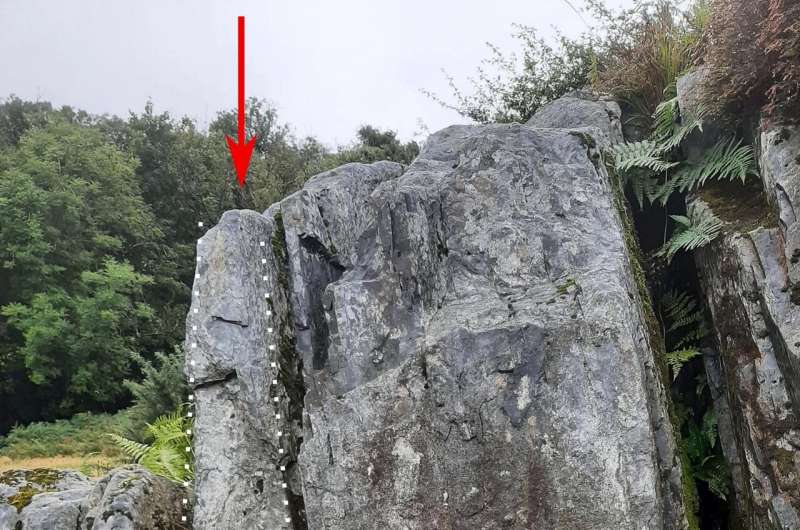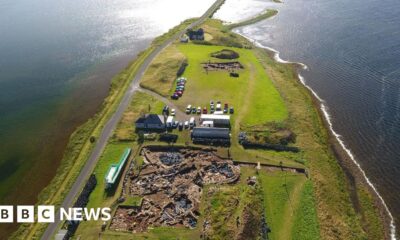Science
New Research Confirms Humans, Not Glaciers, Moved Stonehenge’s Bluestones

A recent study led by researchers from Aberystwyth University has determined that Neolithic people, rather than glacial transport, were responsible for bringing the bluestones to Stonehenge. The findings center on a specific fragment known as the Newall boulder, sourced from Craig Rhos-y-Felin in Wales, located over 200 kilometers from the iconic monument.
The research, published on July 23, 2025, in the Journal of Archaeological Science: Reports, addresses a long-standing debate about how these smaller blue-hued megaliths arrived at Salisbury Plain. While many archaeologists have suggested deliberate human transport, others have argued that glacial ice may have played a role during prehistoric periods.
The Newall boulder, measuring 22 × 15 × 10 cm, has been pivotal in this discussion. Recovered during an excavation led by Lt-Col Hawley in 1924, it was kept by R.S. Newall, who retained 18 stones from the site. Previous studies conducted by the Institute of Geological Sciences in the 1970s and the Open University in the 1980s provided some insights, but the new analysis brings fresh clarity.
In their study, researchers conducted extensive mineralogical, petrographic, and geochemical analyses to trace the boulder’s origins. Results showed that the Newall boulder is consistent with the Rhyolite Group C from Craig Rhos-y-Felin. Morphological comparisons revealed that its bullet-shaped profile aligns with the tops of in situ rhyolite pillars at the same location, further supporting its human transport origins.
No evidence was found to support the theory of glacial movement. The researchers noted the absence of glacial striations on the boulder, with surface abrasions attributed to natural weathering and burial post-breakage. Extensive field investigations across Salisbury Plain have not uncovered any glacial deposits or erratics, which are rocks transported by glaciers.
The lack of glacial erratics, even within a 4-kilometer radius of the monument, strengthens the argument that all bluestones were moved by Neolithic communities. Angular fragments found near Stonehenge exhibited edge damage consistent with deliberate shaping, further indicating human intervention.
Ultimately, the study concludes that the Newall boulder is a remnant of Craig Rhos-y-Felin rhyolite, likely broken off from a monolith such as Stone 32d. The comprehensive data collected supports the notion that the bluestones at Stonehenge are the result of ancient human efforts, rather than glacial processes.
This research not only adds to the understanding of Stonehenge’s construction but also highlights the ingenuity of Neolithic societies in their monumental undertakings. For further details on the study, refer to the article by Richard E. Bevins et al., titled “The enigmatic ‘Newall boulder’ excavated at Stonehenge in 1924: New data and correcting the record,” published in the Journal of Archaeological Science: Reports in 2025.
-

 Entertainment3 months ago
Entertainment3 months agoAnn Ming Reflects on ITV’s ‘I Fought the Law’ Drama
-

 Entertainment4 months ago
Entertainment4 months agoKate Garraway Sells £2 Million Home Amid Financial Struggles
-

 Health3 months ago
Health3 months agoKatie Price Faces New Health Concerns After Cancer Symptoms Resurface
-

 Entertainment3 months ago
Entertainment3 months agoCoronation Street’s Carl Webster Faces Trouble with New Affairs
-

 Entertainment3 months ago
Entertainment3 months agoWhere is Tinder Swindler Simon Leviev? Latest Updates Revealed
-

 Entertainment4 months ago
Entertainment4 months agoMarkiplier Addresses AI Controversy During Livestream Response
-

 World2 weeks ago
World2 weeks agoBailey Announces Heartbreaking Split from Rebecca After Reunion
-

 Science1 month ago
Science1 month agoBrian Cox Addresses Claims of Alien Probe in 3I/ATLAS Discovery
-

 Health4 months ago
Health4 months agoCarol Vorderman Reflects on Health Scare and Family Support
-

 Entertainment2 weeks ago
Entertainment2 weeks agoCoronation Street Fans React as Todd Faces Heartbreaking Choice
-

 Entertainment4 months ago
Entertainment4 months agoKim Cattrall Posts Cryptic Message After HBO’s Sequel Cancellation
-

 Entertainment3 months ago
Entertainment3 months agoOlivia Attwood Opens Up About Fallout with Former Best Friend





















